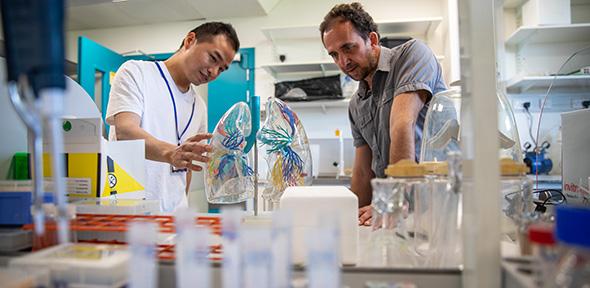
Submitted by Catherine Atkins on Thu, 01/06/2023 - 16:00
In a paper published today in Cancer Cell, Early Cancer Institute Group Leader, Dr Daniel Muñoz Espín and a team of colleagues explain how their new mouse model may increase understanding of the role of senescent cells in lung cancer. This may lead to improved targeted treatments in the future.
Clearance of senescent macrophages ameliorates tumorigenesis in KRAS-driven lung cancer
Background: Senescence is a cellular response to unrepairable damage and oncogenic stress characterised by cell cycle arrest and secretion of a multitude of biological active proteins, referred to as the SASP (senescence-associated secretory phenotype). Mounting evidence suggests that senescent cells, through the SASP, can promote tumour initiation, growth and progression to malignancy in a variety of cancer contexts. Likewise, evidence has demonstrated that senescent cells accumulate in tissues and organs during the normal ageing process, suggesting a possible link between increasing senescent cell burden and cancer risk with age. However, most of the studies have focused on the role of senescence within the tumour cells, with much less emphasis on the role of senescent cells within the tumour microenvironment. Among other reasons, lack of suitable mouse models and universal biomarker/s has limited research on senescence in vivo.
Findings: To overcome this problem, scientists at UCL have generated a new mouse model, termed p16-FDR, that allows the visualisation, isolation and ablation of senescent cells in vivo. Using the p16-FDR in combination with two murine models of lung cancer, UCL and Early Cancer Institute (University of Cambridge) researchers have demonstrated a key role of senescent macrophages in the tumour proliferation and progression to malignancy. A similar senescent macrophage population is present in human lungs bearing premalignant lung tumour lesions. The chemical ablation of macrophages in the mouse models results in reduced lung tumourigenesis and increased mouse survival relative to untreated controls. Mechanistically, senescent macrophages secrete SASP factors that promote tumour growth and immunosuppression. Remarkably, the macrophages found in normal lungs of aged mice show the same molecular signatures that the pro-tumourigenic senescent macrophages identified in tumourigenic lungs.
Meaning: Our results have uncovered new insights into the role of senescent cells in lung cancer, revealed similarities in the SASP between pro-tumourigenic senescent macrophages and senescent macrophages present in non-tumourigenic aged lungs, and provided proof-of-principle supporting that targeting of senescent macrophages may be clinically relevant against human lung cancer.
